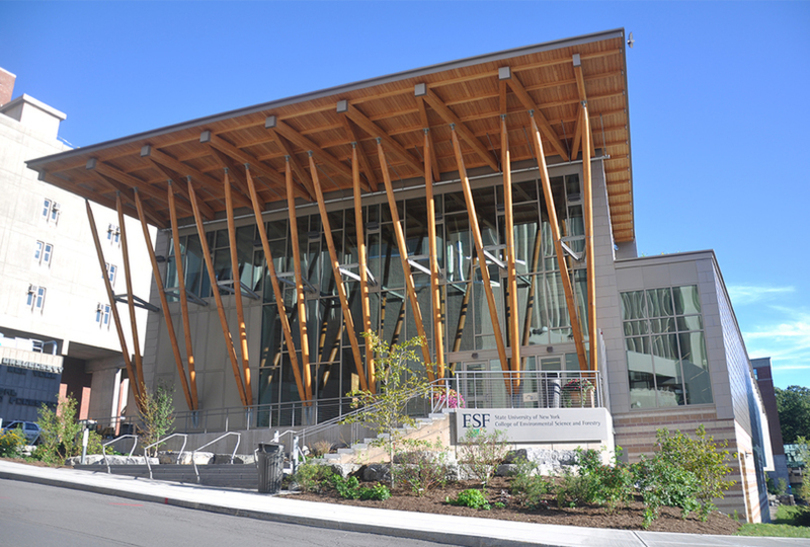SUNY-ESF passes resolution to increase bathroom equity, targeting gender and accessibility

Daily Orange File Photo
The SUNY-ESF administration is to present the results of its bathroom study and plans for renovation by May 11, the next Academic Governance meeting.
SUNY-ESF faculty have asked the university to examine its on-campus bathrooms, which some say are not accommodating to all students.
The State University of New York College of Environmental Science and Forestry’s Academic Governance body recently passed a resolution, 44-11, calling for bathroom equity on campus. Faculty have said a lack of accessibility has plagued SUNY-ESF for years, leaving some students — especially transgender students — often feeling uncomfortable using the bathrooms.
The resolution asks the administration to conduct a bathroom audit, change the signage of some bathrooms in the Gateway Center, renovate and re-designate other bathrooms across campus and write a policy to improve bathroom equity for future buildings.
“The excuses that I hear are our buildings are old and we don’t have a lot of money, and lack of money in different places, but at some point we need to invest in the comfort in the people that work here,” said Kelley Donaghy, an associate professor of chemistry and one of the co-writers of the resolution.
The administration is to present its results of the study and plans for renovation by May 11, the next Academic Governance meeting. While President Quentin Wheeler has expressed support for the resolution, nothing has been done yet to Donaghy’s knowledge, she said.
In Illick Hall, there are 38 places for men to use the bathroom, while only eight for women, according to the resolution. Many of ESF’s buildings were constructed when the campus was predominantly male, the resolution notes, but now the campus sees “more balanced diversity of genders.” Additionally, not all restrooms are Americans with Disabilities Act-compliant, Donaghy said.
The discussion for a resolution only came this semester, though. Donaghy said she was inspired by the film “Hidden Figures,” where one of the main characters, who is black, is forced to walk across campus to use the bathroom because of segregation.
Knowing that many transgender students at SUNY-ESF don’t feel comfortable using the restrooms, Donaghy went to the chemistry department and suggested changing Jahn Laboratory’s third floor women’s restroom into an all-gender bathroom.
While most of the women on the floor supported the change, it was blocked because of a code rule about bathroom equity — the building couldn’t change over a women’s bathroom without changing over a men’s, Donaghy said.
Instead, Sierra Jech, a graduate chemistry student, came up with the idea to change both the men’s and women’s first floor bathrooms in Jahn to all-gender bathrooms, Donaghy said. They created a petition that reached close to 300 signatures.
“We wanted to show the chemistry department that more than just chemistry students would be using the restroom, and we also wanted to show that there was widespread support,” Jech said.
SUNY-ESF’s Undergraduate Student Association voted in support of both the petition and resolution, said Ben Taylor, the organization’s president. The association previously passed a resolution calling for more gender-inclusive bathroom spaces. The issue hasn’t been contentious among students, Taylor said.
But the resolution was debated at the Academic Governance meeting, said Heidi Webb, library technician at ESF and one of the co-writers of the resolution. One of the biggest pushbacks has been over the bathroom codes for buildings.
Brian Boothroyd, assistant director of physical plant for facilities at ESF, who spoke at the meeting, said he is in support of the resolution but added that it’s not as simple as just changing the signs on the doors. While this is a priority and some changes might be easy to make, there needs to be a deeper evaluation of other facilities before major renovations happen, he said.
“A change to accommodate one group might negatively affect another group that we don’t even know of yet,” Boothroyd said.

But Donaghy and Webb argue that there are some bathrooms that can be changed immediately. In Gateway, there are two single-occupancy bathrooms — one labeled for men and the other women — that they said could easily be relabeled. Changing these bathrooms was one of the key points in the resolution.
“Since we have these two single-stall bathrooms that are lockable from the inside,” Donaghy said, “… Why is this even a concern? It should have been done the day after the resolution.”
Another concern was that some of the bathrooms, like the ones in Jahn, were multi-stall. The resolution cites other SUNY campuses with all-gender bathrooms, like SUNY Stony Brook, Geneseo and Oneonta. At the meeting, those arguing against the changes brought up concerns of hygiene and safety.
Janine DeBaise, an instructor of writing and literature classes at ESF, said some of these arguments are “absurd” and that there are no mysterious hygiene issues — men and women can share bathrooms, just like in family homes, she said.
People also argued that women might not feel safe using the same facility as men. Webb said there are holes in this argument, though, and she dislikes it because it says that men can’t control themselves.
“If women don’t feel safe, that’s a larger issue and we need to figure why they don’t feel safe,” Webb said. “It has to be they don’t feel safe beyond the bathroom too, right?”
While most of the SUNY-ESF campus — across faculty, staff and students — seem in support of increasing bathroom equity across campus, Donaghy said that those against the proposal need to consider how it could increase comfort for many on campus.
“When someone says to me, ‘I’m uncomfortable with this,’” Donaghy said, “I want to just say, ‘But other people are uncomfortable with our current circumstances too. Why is your comfort more important?’”




